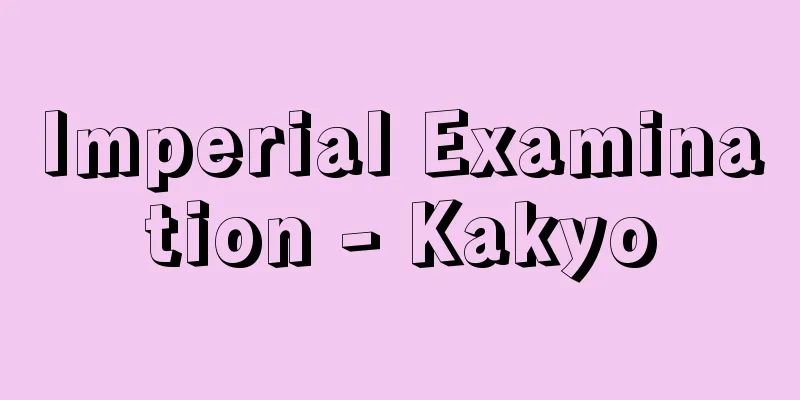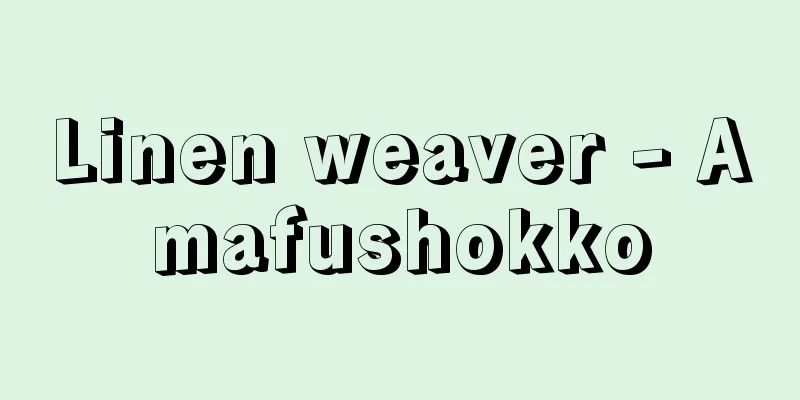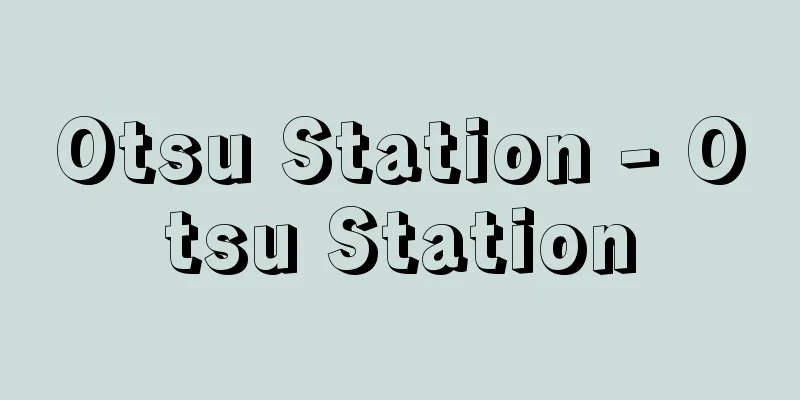Imperial Examination - Kakyo

|
In China, the system of examinations to certify high-ranking civil servants took place from around 587 during the reign of Emperor Wen of the Sui dynasty until 1904, at the end of the Qing dynasty. It is generally mistakenly believed to have begun during the reign of Emperor Yang, who succeeded Emperor Wen. The term "imperial examinations" refers to elections based on subjects, with "elections" referring to the method of appointment to civil servants and "subjects" referring to the fact that the exams included several academic subjects. [Miyazaki City] HistoryAfter the Three Kingdoms period, the Nine Ranks of Officials system was used to appoint officials, but because the selection criteria were based on virtue, this was subjective and easily influenced by personal preferences, and favored the privileged aristocracy, so in the Sui dynasty, this system was switched to the Imperial Examinations, which were objective and fair, and recruited people solely based on talent. At the beginning of the Tang, there were subjects such as Xiucai, Ming Jing, and Jinshi, with Xiucai being political science, Ming Jing being Confucianism, and Jinshi being literature, but gradually only the Jinshi were respected, and many notable people emerged from among them. After the Song dynasty, the names of the various subjects were abolished, the content was integrated, and the single subject, Jinshi, remained, but it was still called the Imperial Examinations. The Tang Dynasty's imperial examinations were divided into two stages. For the Jinshi stage, a preliminary examination was held in the local prefectures, and those who passed were called "Gong" and "Jinshi" and gathered in the capital to take the "Kokyo" examination conducted by the Ministry of Rites along with students selected from other schools in the central area. If they passed the "Kokyo" examination, they were immediately given the title of "Jinshi Passed", and were abbreviated to "Jinshi". The same was true for Mingjing and below. Since the Jinshi was merely a qualification given by the Ministry of Rites, which was the Ministry of Education, when they were actually appointed to the government, they had to take the "Senshi", a separate recruitment examination conducted by the Ministry of Personnel. However, in the Song Dynasty, the "Denshi" examination conducted by the emperor himself was added after the "Kokyo" examination, and since the Jinshi were those who had passed the examination by the emperor, the examination by the Ministry of Personnel became nominal. During the Yuan Dynasty, China was under the control of the Mongols, and the imperial examinations were temporarily suspended, but were revived in 1315 during the reign of Emperor Renzong. During the Ming and Qing dynasties, the exams were held on a larger scale, and because there were so many applicants, they were limited to supervisors and students enrolled in central and local schools. As a result, the entrance exams to become students, called "child exams," became important and looked like preliminary exams for the imperial examinations. During the Qing dynasty, smaller exams were added after the main exams at each stage, making the exams even more complicated. [Miyazaki City] School ExamThe outline of the Qing system is that anyone who sat the entrance exam for local schools was called a child student regardless of age, and there were no restrictions on qualifications except for certain lowly occupations. The child exam was divided into three stages, the first of which was the prefectural exam, conducted by the prefectural governor, who was the head of the prefecture. It took five days to test the Four Books, the Five Classics, poetry, fu, and essays, and at the end, the candidate was required to carefully copy one of the 16 articles of the Qing Dynasty's Imperial Rescript on Education, the Sacred Instructions for the General Instructions. The second stage, the prefectural exam, conducted by the prefectural governor, and the third stage, the postgraduate exam, conducted by the educational administrator, were almost the same. The educational administrator was a high-ranking official in charge of education in a province, and had power on a par with that of the governor-general and governor. The educational administrator traveled around the provinces under his jurisdiction twice every three years to conduct postgraduate exams for those who passed the prefectural exam. Those who passed were assigned to prefectural and prefectural schools and became their students. Schools have academic officials such as professors, teachers, and instructors, but they do not teach classes. Students must study on their own and take an annual examination by the academic administration, which is held every time the graduate school entrance exam is held. Rewards and punishments are given according to performance, and students with excellent results are transferred to a central university. Students are given treatment equivalent to civil servants, and at the same time are expected to behave in a way that does not bring shame to their status. Students who wish to take the imperial examination as students must take the academic examination, which is held at the same time as the graduate school entrance exam, to have their academic ability certified. [Miyazaki City] Imperial ExaminationThe main examination for the Imperial Examinations was divided into three stages: the local exam, the imperial exam, and the palace exam. Those who passed the local exam were given the qualification to become a juren. The imperial exam was sometimes called the Gongju, following the name of the Tang and Song dynasties, and in order to qualify, candidates had to take the juren exam (Fukushi) immediately beforehand and register. After the main exam, the imperial exam, there was a Kaishi exam (Fukushi), and after the results of the main exam were compared with the candidate's results to confirm that he or she was the correct person, candidates were allowed to take the palace exam. Those who passed the palace exam were given the title of Jinshi, and were eligible to be appointed as high-ranking civil servants. The ceremony to announce the results of the Jinshi exams was held in a grand manner at the palace, with the Emperor in attendance and all the officials gathered. This was called Denro or Shomei. Either way, the name is called out by name, and candidates' names are called out three times in order of their scores. The top rank was called Zhuangyuan, the second rank was called Bangyan, and the third rank was called Tanhua, and they were given particularly high honors. Many Zhuangyuan went on to become prime ministers and loyal subjects. Wen Tianxiang of the Song Dynasty was an example of someone who held both positions. Zhuangyuan often appear as protagonists in novels and plays. [Miyazaki City] Merits and demeritsThe Imperial Examinations were close to the ideal of philosopher government and were a very advanced system in that they required officials to be highly educated. Since the end of the Ming Dynasty, they have been introduced to the West and have been praised, and it is said that the higher civil service examination systems in modern civilized countries are influenced by the Chinese Imperial Examinations. However, in reality, there were many problems with the examinations, and there has been constant discussion about the unfairness of the examinations and the fraudulent methods used by examiners. The government tried to make the exams as fair as possible, and for the local and court examinations, they had examiners examine the answers by gluing the names on the answers and then copying them in full, which was called "paste-name" or "transcription." However, they still faced criticism from outside, and it was not uncommon for rebel leaders to emerge from among those who failed. When Western culture was imported to the late Qing Dynasty, the Imperial Examinations no longer suited the times, and they were abolished, giving way to school education. [Miyazaki City] Influence on foreign countriesThe imperial examination system was also imported into Korea, a country that was deeply influenced by China, and continued to be implemented after 958. Japan's Yoro-ryo also contained provisions for tribute examinations, but because there was not yet a sufficient number of intellectuals at the time, it was implemented only a few times as a formality and then disappeared. [Miyazaki City] "Imperial Examinations" by Miyazaki Ichijo (Chuko Shinsho) ©Shogakukan "> The Qing Dynasty Imperial Examination System Source: Shogakukan Encyclopedia Nipponica About Encyclopedia Nipponica Information | Legend |
|
中国で隋(ずい)の文帝の587年ごろから清(しん)朝末期の1904年まで行われた高級国家公務員資格の認定試験制度。普通、文帝の次の煬帝(ようだい)の時代に始まるとされるのは誤り。科挙とは科目による選挙の意味で、選挙とは官吏登用法のこと、科目とは試験に数種の学科目があることをいう。 [宮崎市定] 沿革三国時代以後、九品官人(きゅうひんかんじん)法による官吏登用が行われ、これは選抜の標準を徳行に置くため主観的で情実が入りやすく、特権貴族階級に有利に行われたので、隋になって客観的で公平な試験により、もっぱら才能によって人を採用する科挙に切り換えたのである。唐初は秀才、明経(めいけい)、進士などの科目があり、秀才は政治学、明経は儒学、進士は文学であったが、しだいに進士だけが尊重され、そのなかから多くの名士が出た。宋(そう)代以後、諸科目の名を廃し、内容を統合して進士一科の名を残したが、依然として科挙と称せられた。 唐代の科挙は2段に分かれ、進士科ならば地方の州で予備試験を行い、通過した者は郷貢(きょうこう)、進士と称し、都に集まって、別に中央の学校から選抜された生徒とともに、礼部が行う貢挙(こうきょ)を受ける。貢挙を通過すると、ただちに進士及第の称号を受け、略して進士という。明経以下も同じである。進士は文部省にあたる礼部が与えた資格にすぎないので、彼らが実際に任官するときは、別に吏部が行う採用試験である詮試(せんし)を受けなければならなかった。しかし宋(そう)代には貢挙のあとに天子自ら行う殿試(でんし)が付加され、進士は天子の審査を経た者なので、吏部の試験は名目的なものとなった。元代は中国がモンゴル人の支配下にあり、科挙が一時停止されたが、仁宗(じんそう)の時代1315年に再興された。明(みん)、清に至っていっそう盛大に行われ、志願者があまり多数に上ったので、これを中央、地方の学校在籍者の、監生(かんせい)、生員(せいいん)に限ることとした。すると生員になるための入学試験、童試(どうし)が重要となり、あたかも科挙の予備試験の観を呈した。清代になり各段階の本試験のあとにさらに小試験が付加されて、いよいよ複雑となった。 [宮崎市定] 学校試清代制度の大要を述べると、地方学校の入試である童試に応ずる者は年齢にかかわらず童生(どうせい)といい、特殊の賤業(せんぎょう)を除いて資格に制限がない。童試は3段に分かれ、第一段の県試は県の長官である知県が行い、5日かかって四書、五経、詩、賦(ふ)、論を試験し、最後に清朝の教育勅語である聖諭広訓(せいゆこうくん)の16条のなかの1条を謹写させた。第二段の知府が行う府試、第三段の学政が行う院試も、ほとんど同じである。学政とは一省の教育をつかさどる大官で、総督、巡撫(じゅんぶ)と肩を並べる権力をもつ。学政は3年の間に2回、管内の府を巡回して、府試の合格者に対し院試を行う。その合格者は府学、県学に配属されてその生員となる。学校には教授、教諭、訓導などの学官があるが、別に授業は行わない。生員は自学自習して勉学を怠らず、院試のたびごとに行われる学政の歳試(さいし)を受けなければならない。成績に従って賞罰があり、成績優秀な者は中央の太学(たいがく)へ籍を移される。生員は官吏に準ずる待遇を与えられ、同時に身分に恥じない行動を要求される。生員にして科挙に応じようとする者は、院試と同時に行われる科試(かし)を受けて学力の認定を得なければならない。 [宮崎市定] 科挙試科挙の本試験は、郷試、会試、殿試の3段階に分かれ、郷試を通過すれば挙人の資格を与えられる。会試は唐・宋の名に従って貢挙とよばれることもあり、これに応ずるためには、その直前に挙人覆試(ふくし)の試験を受けて登録をしておかなければならない。さらに会試の本試験のあとに会試覆試があり、本試験の成績と照合して本人に相違ないことを確かめたのちに殿試に赴くことを許される。殿試を通過すれば進士という称号を受け、高級公務員に任用される資格を得る。進士合格発表式は宮中で天子親臨し百官が集まった前で盛大に挙行された。これを伝臚(でんろ)または唱名(しょうめい)という。いずれも姓名をよぶ意味で、成績順に名を三度ずつ呼び上げられる。首席を状元(じょうげん)、次席を榜眼(ぼうがん)、三席を探花(たんか)と称し、とくに大きな名誉を与えられた。状元からは宰相に上った者や、忠臣も少なからず出た。宋の文天祥(ぶんてんしょう)はその両者を兼ねた例である。小説、戯曲の主人公にもよく状元が登場する。 [宮崎市定] 功罪科挙は哲人政治の理想に近く、官吏に高い教養を要求するのは甚だ進歩した制度であり、明末以来、西洋に紹介されて賞賛を博し、近代文明国における高等文官試験制度は中国の科挙の影響によるといわれる。しかし、その実際をみれば問題が多く、審査の不公平、受験者の不正手段がつねに論議された。政府は極力公平を期し、郷試、会試には、糊名(こめい)、謄録(とうろく)といい、答案の姓名の部分を糊(のり)で封じ、その全文を筆写したものを試験官に審査させたが、なお外部の非難を免れず、落第者のなかから反乱指導者が現れることもまれではない。清末に西洋文化が輸入されると、科挙は時勢にあわなくなり、学校教育にその地位を譲って廃止された。 [宮崎市定] 外国への影響科挙は、中国の影響を受けることの深い朝鮮にも輸入され、958年以後継続実施された。日本の養老令(ようろうりょう)にも貢挙の規定があるが、当時まだ十分な知識層が存在しなかったので、数回形式的に実施されただけで消滅した。 [宮崎市定] 『宮崎市定著『科挙』(中公新書)』 ©Shogakukan"> 清代の科挙試制度 出典 小学館 日本大百科全書(ニッポニカ)日本大百科全書(ニッポニカ)について 情報 | 凡例 |
Recommend
Yi Kyubo (English name)
[Born] Isejō 22 (1168) [Died] King Gojong 28 (1241...
House of seclusion - Chikkyo
〘noun〙① The underground hibernation of insects and...
Easter Sunday
…The period from Easter to Pentecost is called Ea...
Lee Jae-in
Date of birth and death unknown. Chinese painter ...
Issuikai - Issuikai
An art group for Western painting. It was founded...
The Aleppo Codex
The Aleppo Codex is a copy of the Hebrew Bible bel...
Pseudoelastic strain - pseudoelastic strain
…The recovery component is divided into an elasti...
Blue hair - Aoge
〘Noun〙 The name of the coat color of horses and ot...
Gross Profit
・Gross profit・Gross profit = Sales revenue - Cost ...
Giulini - Carlo Maria Giulini
1914‐ Italian conductor. He studied under Toscanin...
Reed frog - Reed frog (English spelling)
A general term for small frogs with translucent sk...
Yellow mouth - Yellow mouth
[Noun] 1. The beak of a baby bird is yellow. Also,...
Chirinabe - Chirinabe
A type of hot pot dish. It is popular in Osaka, a...
Ultra-high magnetic field
A magnetic field of 70 to 100 T or more is usually...
roving
...A machine that thins the drawn sliver (short f...









